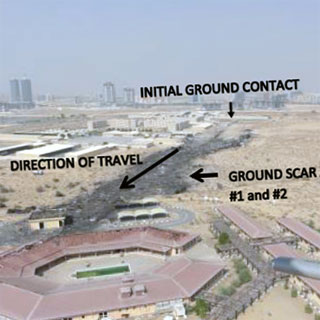
Impact site of UPS – Boeing – B747-44AF (N-571UP) flight UPS6
UPS flight UPS6 , a Boeing 747-44AF departed Dubai International Airport [DXB] on September 03rd 2010 on a scheduled international cargo flight [SCAT-IC] to Cologne [CGN], Germany.
Twenty two minutes into the flight, at approximately 32,000 feet, the crew advised Bahrain Area East Air Traffic Control [BAE-C ] that there was an indication of an on-board fire on the Forward Main Deck and declared an emergency.
Bahrain Air Traffic Control advised that Doha International Airport [DOH] was ‘at your ten o’clock and one hundred miles, is that close enough?’, the Captain elected to return to DXB, configured the aircraft for the return to Dubai and obtained clearance for the turn back and descent.
A cargo on the main cargo deck had ignited at some point after departure. Less than three minutes after the first warning to the crew, the fire resulted in severe damage to flight control systems and caused the upper deck and cockpit to fill with continuous smoke.
The crew of flight UPS6 advised Bahrain East Area Control that the cockpit was “full of smoke” and that they “could not see the radios”.
At around the same time the crew experienced pitch control anomalies during the turn back and descent to 10.000 feet.
The smoke did not abate during the emergency impairing the ability of the crew to safely operate the aircraft for the duration of the flight back to DXB.
On the descent to ten thousand feet the captains supplemental oxygen supply abruptly ceased to function without any audible or visual warning to the crew five minutes and thirty seconds after the first audible warning. This resulted in the Captain leaving his position.
The Captain left his seat and did not return to his position for the duration of the flight due to incapacitation from toxic gases.
The First Officer [F.O], now the Pilot Flying [PF] could not view outside of the cockpit, the primary flight displays, or the audio control panel to retune to the UAE frequencies.
Due to the consistent and contiguous smoke in the cockpit all communication between the destination [DXB] and the crew was routed through relay aircraft in VHF range of the emergency aircraft and BAE-C.
BAE-C then relayed the information to the Emirates Area Control Center (EACC) in the UAE via landline, who then contacted Dubai ATC via landline.
As the aircraft approached the aerodrome in Dubai, it stepped down in altitude, the aircraft approached DXB runway 12 left (RWY 12L), then overflew the northern perimeter of the airport at 4500 ft at around 340 kts . The PF could not view the Primary Flight Displays [PFD] or the view outside the cockpit.
The PF was advised Shajah International Airport [SHJ] was available at 10 nm. This required a left hand turn, the aircraft overflew DXB heading East, reduced speed, entering a shallow descending right-hand turn to the south of the airport before loss of control in flight and an uncontrolled descent into terrain, nine nautical miles south west of Dubai International Airport.
There were no survivors.
- A large fire developed in palletized cargo on the main deck at or near pallet positions 4 or 5, in Fire Zone 3, consisting of consignments of mixed cargo including a significant number of lithium type batteries and other combustible materials. The fire escalated rapidly into a catastrophic uncontained fire.
- The large, uncontained cargo fire, that originated in the main cargo deck caused the cargo compartment liners to fail under combined thermal and mechanical loads.
- Heat from the fire resulted in the system/component failure or malfunction of the truss assemblies and control cables, directly affecting the control cable tension and elevator function required for the safe operation of the aircraft when in manual control.
- The uncontained cargo fire directly affected the independent critical systems necessary for crew survivability. Heat from the fire exposed the supplementary oxygen system to extreme thermal loading, sufficient to generate a failure. This resulted in the oxygen supply disruption leading to the abrupt failure of the Captain’s oxygen supply and the incapacitation of the captain.
- The progressive failure of the cargo compartment liner increased the area available for the smoke and fire penetration into the fuselage crown area.
- The rate and volume of the continuous toxic smoke, contiguous with the cockpit and supernumerary habitable area, resulted in inadequate visibility in the cockpit, obscuring the view of the primary flight displays, audio control panels and the view outside the cockpit which prevented all normal cockpit functioning.
- The shutdown of PACK 1 for unknown reasons resulted in loss of conditioned airflow to the upper deck causing the Electronic Equipment Cooling [EEC] system to reconfigure to “closed loop mode”. The absence of a positive pressure differential contributed to the hazardous quantities of smoke and fumes entering the cockpit and upper deck, simultaneously obscuring the crew’s view and creating a toxic environment.
- The fire detection methodology of detecting smoke sampling as an indicator of a fire is inadequate as pallet smoke masking can delay the time it takes for a smoke detection system to detect a fire originating within a cargo container or a pallet with a rain cover.
Download Report

I just watched the Air Disasters episode about this. I’ve seen a lot of episodes but this made me very emotional because the pilot and copilots were flying blind with little breathing air.